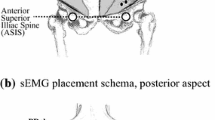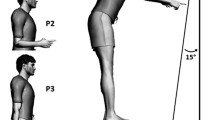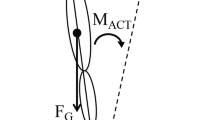Abstract.
In the light of experimental results showing significant forward centre of mass (CoM) displacements within the base of support, this study investigated if whole body reaching movements can be executed whilst keeping the CoM fixed in the horizontal axis. Using kinematic simulation techniques, angular configurations were recreated from experimental data imposing two constraints: a constant horizontal position of the CoM and an identical trajectory of the hand to grasp an object. The comparison between recorded and simulated trials showed that stabilisation of the CoM was associated with greater backward hip displacements, which became more marked with increasing object distance. This was in contrast to recorded trials showing reductions in backward hip displacements with increasing distance. Results also showed that modifications to angular displacements were necessary only at the shoulder and hip joints, but that these modifications were within the limits of joint mobility. The analysis of individual joint torques revealed that the pattern and timing of simulated trials were similar to those recorded experimentally. Peak joint torque values showed particularly that keeping the CoM at a constant horizontal position resulted in significantly smaller ankle peak flexor and extensor torques. It may be concluded from this study that `stabilising' the CoM during human whole body reaching represents a feasible strategy, but not the one chosen by subjects under experimental conditions. Our results also do not support the idea of the CoM as the stabilised reference value for the coordination between posture and goal-directed movements.
Similar content being viewed by others
Author information
Authors and Affiliations
Additional information
Received: 22 September 1998 / Accepted in revised form: 2 June 1999
Rights and permissions
About this article
Cite this article
Stapley, P., Pozzo, T., Grishin, A. et al. Investigating centre of mass stabilisation as the goal of posture and movement coordination during human whole body reaching. Biol Cybern 82, 161–172 (2000). https://doi.org/10.1007/s004220050016
Issue Date:
DOI: https://doi.org/10.1007/s004220050016




